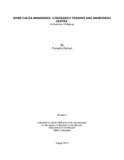River halda awakening: a research training and awareness centre at Burischar, Chittagong
Abstract
The Halda River, originating from a hill creek at Ramgarh Upazilla in the hill-tract district of Khagrachhari is
famous as the fish-mine of Bangladesh. This River and its waters have some unique physical chemical and
biological features which generate a favorable atmosphere for four types of carp fishes, rohu, catla catla, mrigal
and kalibaush to lay their eggs in the depths of the river bends, where generated whirlpools help in the process
of the lifecycle. The focal physical feature, the ox bow bends of this river, combined with various other chemical
and biological features such as the marshlands alongside the river edge, give this river its character and life
allowing it to be the richest natural spawning ground of these four species of major carps from the time of its
formation.
In the 1960s, this river had more life than it has now, producing 3 times the volume of fishes and so generating
three times the amount of activity along this river. All this has experienced a major phase of diminishment,
generating a situation of large scale depression for the fishermen. The River life degradation is mainly for the
straightening of the river ox bow bends along the river edge, which is the source point of fish life generation.
The community takes up this methodology in order to protect their homesteads and properties from the
disasters of river edge erosion. This approach to the river that the people have adapted to is a cause for the
lack of awareness and negligence by the existing government projects and also because the locals lack
knowledge about the scientific issues related to this river.
Such disregard to a natural source is leading to illegal fishing of mother fish, improper river edge protection
method development and so on. This, in turn leads to the decrease of fish egg generation, which further
relates to less economic generation and creates a break in the natural cycle. Due to decreasing opportunity in
fisheries sector of this river, most farmers are shifting from that of being a fisherman to agricultural farmers.
The idea behind this project generated from this original of providing a platform for the fishermen, which will
help reach out and allow development and interaction of this community at a local scale. It will further achieve
awareness at a wider scale, reaching out to other cities and countries in the process of research, conservation
and archiving. Functionally developing the project into providing training spaces, research facilities, and
exhibition spaces and various awareness programs and processes was based on this hypothesis, so as to
support a community and generate a program that has evolved from the site within.
The focus of this project was to generate an architecture that celebrates itself within nature giving the river and
its surrounding a more valuable meaning, not taking up the space that it will occupy but instead giving back to
nature in multiples of what it is taking.

